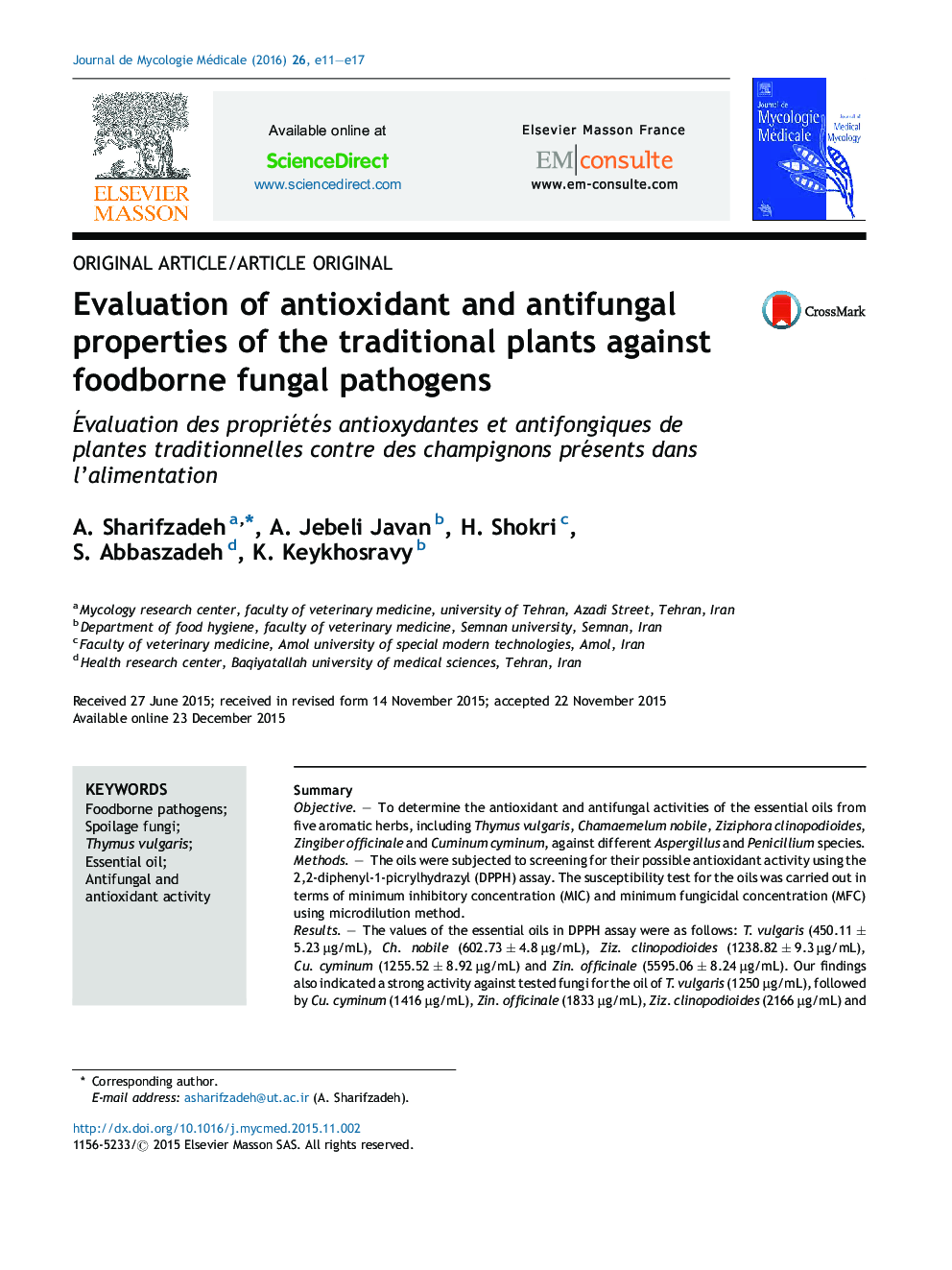| Article ID | Journal | Published Year | Pages | File Type |
|---|---|---|---|---|
| 3219183 | Journal de Mycologie Médicale / Journal of Medical Mycology | 2016 | 7 Pages |
SummaryObjectiveTo determine the antioxidant and antifungal activities of the essential oils from five aromatic herbs, including Thymus vulgaris, Chamaemelum nobile, Ziziphora clinopodioides, Zingiber officinale and Cuminum cyminum, against different Aspergillus and Penicillium species.MethodsThe oils were subjected to screening for their possible antioxidant activity using the 2,2-diphenyl-1-picrylhydrazyl (DPPH) assay. The susceptibility test for the oils was carried out in terms of minimum inhibitory concentration (MIC) and minimum fungicidal concentration (MFC) using microdilution method.ResultsThe values of the essential oils in DPPH assay were as follows: T. vulgaris (450.11 ± 5.23 μg/mL), Ch. nobile (602.73 ± 4.8 μg/mL), Ziz. clinopodioides (1238.82 ± 9.3 μg/mL), Cu. cyminum (1255.52 ± 8.92 μg/mL) and Zin. officinale (5595.06 ± 8.24 μg/mL). Our findings also indicated a strong activity against tested fungi for the oil of T. vulgaris (1250 μg/mL), followed by Cu. cyminum (1416 μg/mL), Zin. officinale (1833 μg/mL), Ziz. clinopodioides (2166 μg/mL) and Ch. nobile (3750 μg/mL). This study confirmed the excellent antifungal and antioxidant properties of the essential oils, especially T. vulgaris, against foodborne pathogenic fungi.ConclusionOwing to their strong protective features, these oils could be used in ethno-medicine as preventers of lipid peroxidation and cellular damage, and in food industries as preservers of foodstuffs against spoilage fungi. Also, they could be the candidates to develop new antibiotics and disinfectants to control infective agents.
RésuméObjectifDéterminer les activités antioxydantes et antifongiques des huiles essentielles de cinq herbes aromatiques : Thymus vulgaris, Chamaemelum nobile, Ziziphora clinopodioides, Zingiber officinale et Cuminum cyminum, contre différentes espèces d’Aspergillus et de Penicillium.Matériel et méthodesLes huiles ont été examinées pour leur activité antioxydante possible en utilisant le 2,2-diphenyl-1-picrylhydrazyl (DPPH). Le test de sensibilité pour les huiles a porté sur la concentration minimale inhibitrice (MIC) et la concentration minimale fongicide (MFC) en utilisant la méthode de microdilution.RésultatsLes valeurs des huiles essentielles dans l’essai DPPH étaient comme suit : T. vulgaris (450,11 ± 5,23 μg/mL), Ch. nobile (602,73 ± 4,8 μg/mL), Ziz. clinopodioides (1238,82 ± 9,3 μg/mL), Cu. cyminum (1255,52 ± 8,92 μg/mL) et Zin. officinale (5595,06 ± 8,24 μg/mL). Nos résultats ont aussi indiqué une forte activité contre les champignons testés pour les huiles de T. vulgaris (1250 μg/mL), suivi par Cu. cyminum (1416 μg/mL), Zin. officinale (1833 μg/mL), Ziz. clinopodioides (2166 μg/mL) et Ch. nobile (3750 μg/mL). Cette étude a confirmé les propriétés antifongiques et antioxydantes excellentes des huiles essentielles, surtout de T. vulgaris, contre les champignons potentiellement pathogènes de l’alimentation.ConclusionEn raison de leurs fortes caractéristiques protectrices, ces huiles pourraient être utilisées dans l’ethnomédecine en prévention de la peroxidation lipidique et du dommage cellulaire et dans les industries de nourriture comme des préservateurs de denrées alimentaires contre les champignons qui les altèrent. Aussi, ils pourraient être les candidats pour développer de nouveaux antibiotiques et des désinfectants pour contrôler des agents infectieux.
